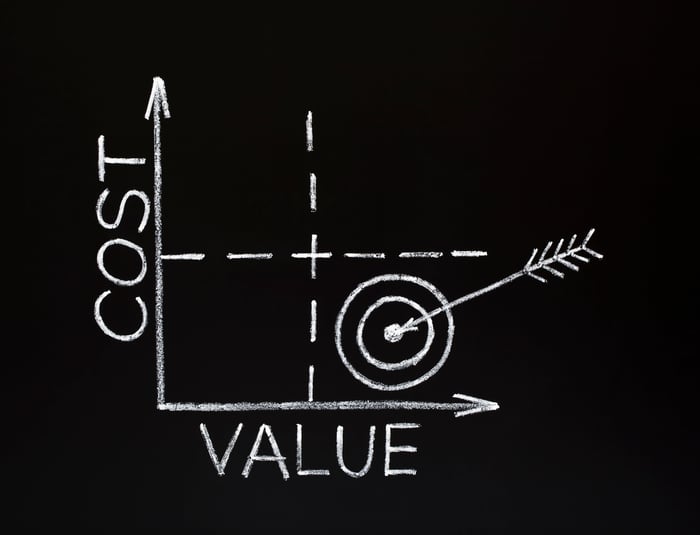
Image source: Getty Images.
A million bucks is a lot of money. In fact, it's about five times the typical American household's net worth at retirement. If you want to join the ranks of those with a cool million or more by the time you retire, you need a strong plan to get you there. These 11 steps can get you on the path toward a million-dollar retirement.

Image source: Getty Images.
1. Start early
The earlier you start saving for your retirement, the better your chances of reaching that million-dollar target. Assuming your money grows at an average rate of 8% per year, you'll only need to invest about $285 per month to get there if you have 40 years of work ahead of you. If you wait until you only have 20 years of work left, you'll have to sock away nearly $1,700 per month, and if you only give yourself 10 years, it'll take nearly $5,500 per month.

Image source: Getty Images.
2. Take advantage of all the "free money" you can
Many companies offer 401(k) matches as part of their compensation package. The catch with employer matches is that you need to defer a portion of every paycheck to your 401(k) in order to get the company's money. However, if you do contribute, you'll get an immediate return on investment of 50% to 100%, depending on your employer's match -- and that's virtually unbeatable.
Regardless of whether the money comes from you or from your boss, it all counts toward that million-dollar savings goal. Still, the more matching contributions you get from your employer, the less you have to come up with out of your own pocket.

Image source: Getty Images.
3. Make it automatic
Have your 401(k) contributions directly withdrawn from your paycheck. Set up a recurring deposit into your IRA on every payday. If you leave it up to yourself to contribute to your retirement accounts every week or two, then inertia and the urge to spend money will work against you. When you automate your retirement savings, no further effort is needed on your part, and you won't miss the money, as it will never be in your hands.

Image source: Getty Images.
4. Boost your savings rate every time you get a raise
If you can make ends meet on your current paycheck, then any raises you get represent money you don't technically need to cover your costs of living. By increasing your retirement savings each time you get a raise, you get yourself closer to that million-dollar goal without affecting your lifestyle. A good rule of thumb once your savings rate is on track is to increase your savings by half your raise amount. That way, you get to enjoy the benefit of your hard work and accomplishments now while still improving your chances of reaching your goal.

Image source: Getty Images.
5. Keep your investing costs low
Over time, the stock market has returned around 9.5% annualized returns. Assuming the future looks somewhat like the past, investing $1,000 a month at that rate would get you to millionaire status in just over 23 years.
However, if investment costs like mutual fund fees and account maintenance fees eat up just 2 percentage points of your returns, it'll take you closer to $1,350 per month to reach the same goal in the same amount of time. That's essentially a 35% increase in the money you need to save each month, driven entirely by fees.

Image source: Getty Images.
6. Be prepared for bad stretches in the market
The stock market has been a great wealth-generator over time, but its path has been anything but straight up. There have been periods -- some lasting a decade or more -- when stocks have declined in price. However, it's vital that you keep investing new money and sticking to your strategy, even when bear markets eat away at your nest egg.
History favors investors who keep their heads when the market takes a dive. Let's use the recent Great Recession as an example. Those who sold when the market hit bottom ate losses of about 50% on average. However, since the lows of 2009, the market has gained about 250%, so those who stayed invested have made their money back and then some. Meanwhile, those who bought more during the recession have enjoyed even bigger gains, because they bought equities at bargain-basement prices.

Image source: Getty Images.
7. Set a reasonable target return for your investments
While the stock market has delivered annualized returns of around 9.5% over the long haul, there are no guarantees it will do so going forward. In addition, with interest rates near historic lows, it's unlikely that long-run returns in bonds will be much above 3%, which 30-year Treasuries currently yield. If your investment return expectations are higher than that based on whatever mix of stocks and bonds you hold, you're putting yourself in a risky position. Invest with the expectation that your returns will be lower than the historical average, and you'll improve your chances of reaching your million-dollar retirement target.

Image source: Getty Images.
8. Let your time frame determine your allocation choices
Over the short run, stocks are risky because of their volatility. Over the long run, bonds and cash are risky because they offer lower returns than stocks and thus have a harder time keeping up with inflation and taxes. Money you need to spend within the next five years or so does not belong in stocks, but money you can leave untouched for many years has a better chance of outpacing inflation if invested in stocks. By choosing investments based on when you need to spend that money, you improve your chances of having the money you need, when you need it.

Image source: Getty Images.
9. If you can't beat the market, track it
The vast majority of professionally managed mutual funds fail to beat the market over time. Unless you have the talent, time, and temperament to research and invest in individual stocks, your best bet is to invest in index-tracking mutual funds or ETFs. You'll get returns that essentially track the market, along with the low costs you need to keep more of your money compounding for you.

Image source: Getty Images.
10. Leverage tax-advantaged accounts to help you get there faster
Tax-advantaged retirement accounts like IRAs and 401(k)s can help you reach your million-dollar target much faster. All money invested inside those accounts grows tax-deferred, allowing it to compound without capital-gains taxes dragging it down along the way. In traditional IRAs and 401(k)s, your contributions may be deducted from your taxable income, which makes it easier for you to invest more. In Roth-style plans, you typically get to take the money out of your account tax-free in retirement, making each dollar in the account worth that much more. Learn more about these two varieties of IRA here.

Image source: Getty Images.
11. Review your progress regularly -- and adjust if necessary
No matter how strong your plans look as you lay them out on paper, the market and life both have ways of throwing you curve balls that can knock your plans off track. The sooner you recognize that there's a gap between where you need to be and where you actually are along your path to a million-dollar retirement, the easier it is to make the changes needed to get back on track. The road to your million-dollar retirement may take two decades or more to travel, giving life and the market plenty of opportunities to trip you up along the way. Taking the time to review your progress a few times a year helps you maximize your flexibility.
Your savings rate, your investment choices, and the amount of time left until you retire are all levers you can adjust to help you reach your goal. Course corrections made early are easier, cheaper, and less painful than those made later in your journey. So keep close tabs on your progress, and be willing to make those corrections early to give yourself the best shot of retiring a millionaire.




